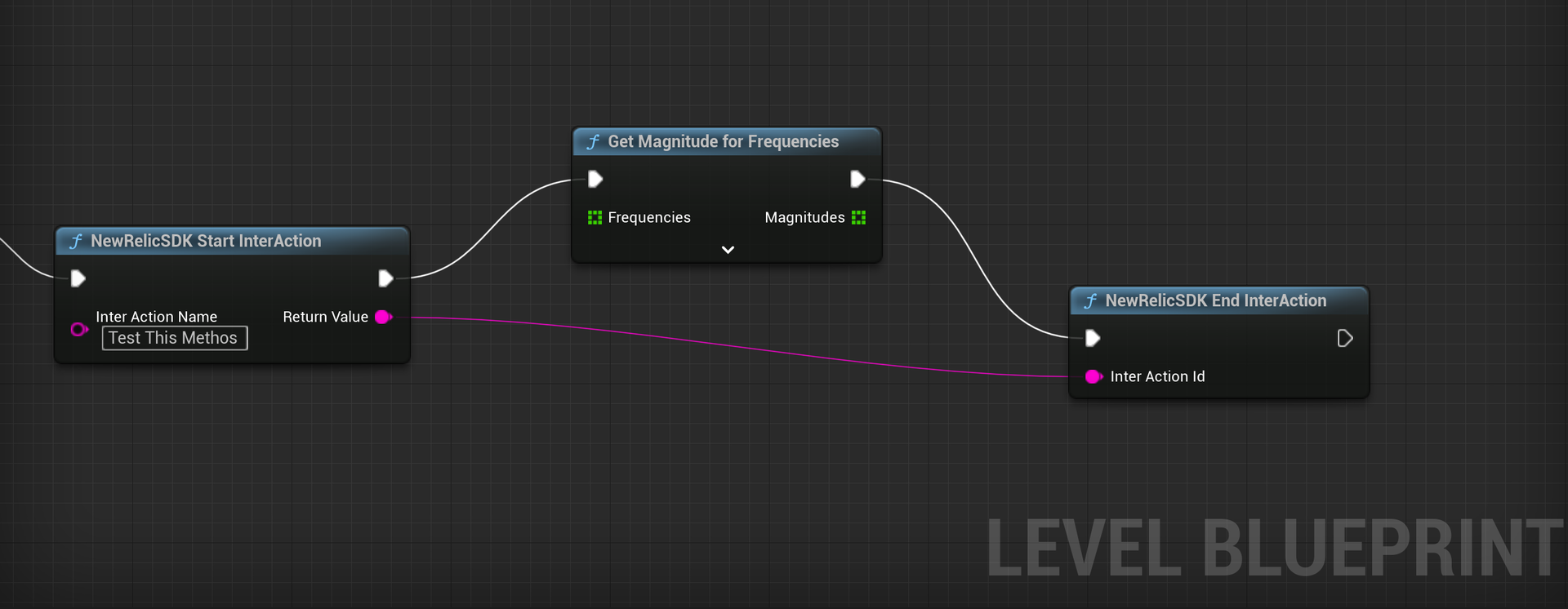Syntaxe
Java
NewRelic.startInteraction(string $interactionName)Kotlin [#kotlin]
NewRelic.startInteraction(actionName: String)Description [#description]
Créez une interaction pour instrumenter une méthode dans le code de votre application Android .
Pour nommer une interaction qui existe déjà et qui est déjà suivie, voir setInteractionName().
Paramètres [#parameters]
paramètres | Type | Description |
|---|---|---|
|
| Requis. Le nom que vous souhaitez donner à l'interaction. |
Valeurs de retour [#return-values]
Renvoie un numéro d'ID d'interaction qui peut être utilisé pour mettre fin à l'interaction à un certain moment.
Exemple [#example]
Voici un exemple de démarrage du suivi d'une interaction nommée RefreshContacts:
Java [#java]
public class MainActivity extends Activity { ... @Override public boolean onOptionsItemSelected(MenuItem item) { switch (item.getItemId()) { case R.id.action_refresh: NewRelic.startInteraction("RefreshContacts"); ... return true; default: return super.onOptionsItemSelected(item); } } ...}Kotlin [#kotlin]
class MainActivity : AppCompatActivity() {
... var client: OkHttpClient = OkHttpClient();
binding.fab.setOnClickListener { view ->
val interActionId = NewRelic.startInteraction("Getting Data From Server")
lifecycleScope.launch(Dispatchers.IO) { val result = getRequest() NewRelic.endInteraction(interActionId) } } } ...Syntaxe
Objectif-C
+ (NSString*) startInteractionWithName:(NSString*)interactionName;Swift [#swift]
NewRelic.startInteraction(string: "myInteractionName")Description [#description]
Cette méthode démarrera une trace d’interaction en utilisant interactionName comme nom. L' interaction enregistrera toutes les méthodes instrumentées jusqu'à ce qu'un délai d'attente se produise ou que stopCurrentInteraction soit appelé.
Pour nommer une interaction qui existe déjà et qui est déjà suivie, voir setInteractionName().
Conseil
Si vous utilisez ces méthodes, l'interaction instrumentée n'apparaîtra pas sur la page d'interaction , mais elles peuvent toujours être trouvées avec une requête NRQL , telle que :
SELECT name FROM Mobile SINCE 7 DAYS AGOParamètres [#parameters]
paramètres | Type | Description |
|---|---|---|
|
| Requis. Le nom que vous souhaitez donner à l'interaction. |
Valeurs de retour [#return-values]
Si startInteractionWithName est appelé, la valeur de retour est un interactionIdentifier qui doit être passé à stopCurrentInteraction . Mais il n'est pas nécessaire d'appeler stopCurrentInteraction après avoir appelé start car startInteractionWithName finira par se terminer intelligemment.
Exemples [#examples][#examples]
Objective-C [#obj-c]
NSString *identifier = [NewRelic startInteractionWithName: @"myInteractionName"];[NewRelic stopCurrentInteraction: identifier];Swift [#swift]
let identifier = NewRelic.startInteraction(withName: "myInteractionName")NewRelic.stopCurrentInteraction(identifier)Syntaxe
startInteraction(options: { value: string; }) => Promise<{ value: string; }>Description [#description]
Suivre une méthode en tant qu'interaction.
Paramètres [#parameters]
paramètres | Type | Description |
|---|---|---|
|
| Requis. Le nom que vous souhaitez donner à l'interaction. |
Exemple [#example]
const badApiLoad = async () => { const id = await NewRelicCapacitorPlugin.startInteraction({ value: 'StartLoadBadApiCall' }); console.log(id); const url = 'https://fakewebsite.com/moviessssssssss.json'; fetch(url) .then((response) => response.json()) .then((responseJson) => { console.log(responseJson); NewRelicCapacitorPlugin.endInteraction({ interactionId: id.value }); }) .catch((error) => { NewRelicCapacitorPlugin.endInteraction({ interactionId: id.value }); console.error(error); });};Syntaxe
startInteraction(interactionName: string, cb?: function): Promise<InteractionId>;Description [#description]
Suivre une méthode en tant qu'interaction.
Paramètres [#parameters]
paramètres | Type | Description |
|---|---|---|
|
| Requis. Le nom que vous souhaitez donner à l'interaction. |
Exemple [#example]
const badApiLoad = async () => { const interactionId = await NewRelic.startInteraction('StartLoadBadApiCall'); console.log(interactionId); const url = 'https://cordova.apache.org/moviessssssssss.json'; fetch(url) .then((response) => response.json()) .then((responseJson) => { console.log(responseJson); NewRelic.endInteraction(interactionId); }) .catch((error) => { NewRelic.endInteraction(interactionId); console.error(error); });}Syntaxe
StartInteraction(string interactionName): string;Description [#description]
Suivre une méthode en tant qu'interaction.
Paramètres [#parameters]
paramètres | Type | Description |
|---|---|---|
|
| Requis. Le nom que vous souhaitez donner à l'interaction. |
Exemple [#example]
HttpClient myClient = new HttpClient(CrossNewRelic.Current.GetHttpMessageHandler());
string interactionId = CrossNewRelic.Current.StartInteraction("Getting data from service");
var response = await myClient.GetAsync(new Uri("https://jsonplaceholder.typicode.com/todos/1"));if (response.IsSuccessStatusCode){ var content = await response.Content.ReadAsStringAsync();} else{ Console.WriteLine("Unsuccessful response code");}
CrossNewRelic.Current.EndInteraction(interactionId);Syntaxe
startInteraction(String actionName);Description [#description]
Suivre une méthode en tant qu'interaction.
Paramètres [#parameters]
paramètres | Type | Description |
|---|---|---|
|
| Requis. Le nom que vous souhaitez donner à l'interaction. |
Exemple [#example]
var id = await NewrelicMobile.instance.startInteraction("Getting Data from Service");
try { var dio = Dio(); var response = await dio.get( 'https://reqres.in/api/users?delay=15'); print(response); NewrelicMobile.instance.endInteraction(id); Timeline.finishSync();} catch (e) { print(e);}Syntaxe
startInteraction(interactionName: string): Promise<InteractionId>;Description [#description]
Suivre une méthode en tant qu'interaction.
Paramètres [#parameters]
paramètres | Type | Description |
|---|---|---|
|
| Requis. Le nom que vous souhaitez donner à l'interaction. |
Exemple [#example]
const badApiLoad = async () => { const interactionId = await NewRelic.startInteraction('StartLoadBadApiCall'); console.log(interactionId); const url = 'https://facebook.github.io/react-native/moviessssssssss.json'; fetch(url) .then((response) => response.json()) .then((responseJson) => { console.log(responseJson); NewRelic.endInteraction(interactionId); }) .catch((error) => { NewRelic.endInteraction(interactionId); console.error(error); });;};Syntaxe
StartInteractionWithName(string interactionName): string;Description [#description]
Suivre une méthode en tant qu'interaction.
Paramètres [#parameters]
paramètres | Type | Description |
|---|---|---|
|
| Requis. Le nom que vous souhaitez donner à l'interaction. |
Exemple [#example]
string interActionId = NewRelicAgent.StartInteractionWithName("Unity InterAction Example");
for(int i = 0; i < 4; i++){ Thread.Sleep(1000);}
NewRelicAgent.StopCurrentInteraction(interActionId);Syntaxe
startInterAction(FString interActionName):FString;Description [#description]
Suivre une méthode en tant qu'interaction.
Paramètres [#parameters]
paramètres | Type | Description |
|---|---|---|
|
| Requis. Le nom que vous souhaitez donner à l'interaction. |
Exemple [#example]
#include "NewRelicBPLibrary.h"
FString id = UNewRelicBPLibrary::startInterAction("test Unreal InterAction");
FPlatformProcess::Sleep(6.0);
UNewRelicBPLibrary::endInterAction(id);
Syntaxe
StartInteraction(string interactionName): string;Description [#description]
Suivre une méthode en tant qu'interaction.
Paramètres [#parameters]
paramètres | Type | Description |
|---|---|---|
|
| Requis. Le nom que vous souhaitez donner à l'interaction. |
Exemple [#example]
HttpClient myClient = new HttpClient(CrossNewRelicClient.Current.GetHttpMessageHandler());
string interactionId = CrossNewRelicClient.Current.StartInteraction("Getting data from service");
var response = await myClient.GetAsync(new Uri("https://jsonplaceholder.typicode.com/todos/1"));if (response.IsSuccessStatusCode){ var content = await response.Content.ReadAsStringAsync();} else{ Console.WriteLine("Unsuccessful response code");}
CrossNewRelicClient.Current.EndInteraction(interactionId);